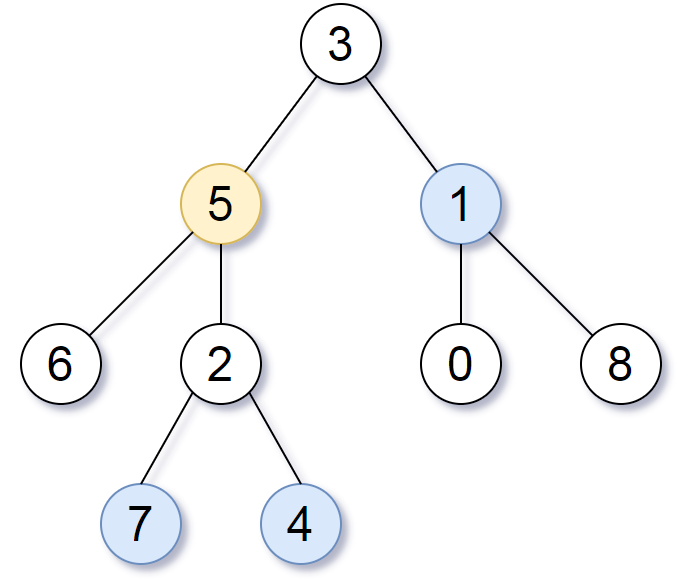原文链接: https://leetcode-cn.com/problems/all-nodes-distance-k-in-binary-tree
英文原文
Given the root of a binary tree, the value of a target node target, and an integer k, return an array of the values of all nodes that have a distance k from the target node.
You can return the answer in any order.
Example 1:

Input: root = [3,5,1,6,2,0,8,null,null,7,4], target = 5, k = 2 Output: [7,4,1] Explanation: The nodes that are a distance 2 from the target node (with value 5) have values 7, 4, and 1.
Example 2:
Input: root = [1], target = 1, k = 3 Output: []
Constraints:
- The number of nodes in the tree is in the range
[1, 500]. 0 <= Node.val <= 500- All the values
Node.valare unique. targetis the value of one of the nodes in the tree.0 <= k <= 1000
中文题目
给定一个二叉树(具有根结点 root), 一个目标结点 target ,和一个整数值 K 。
返回到目标结点 target 距离为 K 的所有结点的值的列表。 答案可以以任何顺序返回。
示例 1:
输入:root = [3,5,1,6,2,0,8,null,null,7,4], target = 5, K = 2 输出:[7,4,1] 解释: 所求结点为与目标结点(值为 5)距离为 2 的结点, 值分别为 7,4,以及 1注意,输入的 "root" 和 "target" 实际上是树上的结点。 上面的输入仅仅是对这些对象进行了序列化描述。
提示:
- 给定的树是非空的。
- 树上的每个结点都具有唯一的值
0 <= node.val <= 500。 - 目标结点
target是树上的结点。 0 <= K <= 1000.
通过代码
高赞题解
基本分析
显然,如果题目是以图的形式给出的话,我们可以很容易通过「BFS / 迭代加深」找到距离为 $k$ 的节点集。
而树是一类特殊的图,我们可以通过将二叉树转换为图的形式,再进行「BFS / 迭代加深」。
由于二叉树每个点最多有 $2$ 个子节点,点和边的数量接近,属于稀疏图,因此我们可以使用「邻接表」的形式进行存储。
建图方式为:对于二叉树中相互连通的节点(root 与 root.left、root 和 root.right),建立一条无向边。
建图需要遍历整棵树,使用 DFS 或者 BFS 均可。
由于所有边的权重均为 $1$,我们可以使用 「BFS / 迭代加深」 找到从目标节点 target 出发,与目标节点距离为 $k$ 的节点,然后将其添加到答案中。
一些细节:利用每个节点具有唯一的值,我们可以直接使用节点值进行建图和搜索。
建图 + BFS
由「基本分析」,可写出「建图 + BFS」的实现。

代码:
[]class Solution { // 根据数据范围最多有 501 个点,每个点最多有 2 条无向边(两个子节点) int N = 510, M = N * 4; int[] he = new int[N], e = new int[M], ne = new int[M]; int idx; void add(int a, int b) { e[idx] = b; ne[idx] = he[a]; he[a] = idx++; } boolean[] vis = new boolean[N]; public List<Integer> distanceK(TreeNode root, TreeNode t, int k) { List<Integer> ans = new ArrayList<>(); Arrays.fill(he, -1); dfs(root); Deque<Integer> d = new ArrayDeque<>(); d.addLast(t.val); vis[t.val] = true; while (!d.isEmpty() && k >= 0) { int size = d.size(); while (size-- > 0) { int poll = d.pollFirst(); if (k == 0) { ans.add(poll); continue; } for (int i = he[poll]; i != -1 ; i = ne[i]) { int j = e[i]; if (!vis[j]) { d.addLast(j); vis[j] = true; } } } k--; } return ans; } void dfs(TreeNode root) { if (root == null) return; if (root.left != null) { add(root.val, root.left.val); add(root.left.val, root.val); dfs(root.left); } if (root.right != null) { add(root.val, root.right.val); add(root.right.val, root.val); dfs(root.right); } } }
- 时间复杂度:通过
DFS进行建图的复杂度为 $O(n)$;通过BFS找到距离 $target$ 为 $k$ 的节点,复杂度为 $O(n)$。整体复杂度为 $O(n)$ - 空间复杂度:因为是二叉树,边数与点数是呈线性关系。复杂度为 $O(n)$
建图 + 迭代加深
由「基本分析」,可写出「建图 + 迭代加深」的实现。
迭代加深的形式,我们只需要结合题意,搜索深度为 $k$ 的这一层即可。

代码:
[]class Solution { // 根据数据范围最多有 501 个点,每个点最多有 2 条无向边(两个子节点) int N = 510, M = N * 4; int[] he = new int[N], e = new int[M], ne = new int[M]; int idx; void add(int a, int b) { e[idx] = b; ne[idx] = he[a]; he[a] = idx++; } boolean[] vis = new boolean[N]; public List<Integer> distanceK(TreeNode root, TreeNode t, int k) { List<Integer> ans = new ArrayList<>(); Arrays.fill(he, -1); dfs(root); vis[t.val] = true; find(t.val, k, 0, ans); return ans; } void find(int root, int max, int cur, List<Integer> ans) { if (cur == max) { ans.add(root); return ; } for (int i = he[root]; i != -1; i = ne[i]) { int j = e[i]; if (!vis[j]) { vis[j] = true; find(j, max, cur + 1, ans); } } } void dfs(TreeNode root) { if (root == null) return; if (root.left != null) { add(root.val, root.left.val); add(root.left.val, root.val); dfs(root.left); } if (root.right != null) { add(root.val, root.right.val); add(root.right.val, root.val); dfs(root.right); } } }
- 时间复杂度:通过
DFS进行建图的复杂度为 $O(n)$;通过迭代加深找到距离 $target$ 为 $k$ 的节点,复杂度为 $O(n)$。整体复杂度为 $O(n)$ - 空间复杂度:因为是二叉树,边数与点数是呈线性关系。复杂度为 $O(n)$
答疑
评论区不少小伙伴对 add 的存图方式有疑问,这里集中回答一下 ~
这是一种在图论中十分常见的存图方式,可直接当作模板进行背过,与数组存储单链表的实现一致。
首先 idx 是用来对边进行编号的,然后对存图用到的几个数组作简单解释:
he数组:存储是某个节点所对应的边的集合(链表)的头结点;e数组:由于访问某一条边指向的节点;ne数组:由于是以链表的形式进行存边,该数组就是用于找到下一条边。
因此当我们想要遍历所有由 a 点发出的边时,可以使用如下方式:
[]for (int i = he[a]; i != -1; i = ne[i]) { int j = e[i]; // 存在由 a 指向 j 的边 }
另外,在评论区 @Meteordream 小姐姐给出了很好的解释:
数组 he 的下标表示结点,值是一个索引 ind,e[ind] 表示 对应一条边,ne[ind] 表示下一个连接结点的索引,假设与 结点a 相连的结点有 b, c, 那么通过 he[a]取得一个索引 ind1 后,通过 e[ind1] = b 可以得到与 a 相连的第一个结点是 b,然后通过 ne[ind1] 可以获得下一个结点的索引 ind2 ,通过 e[ind2] = c 可以得到与 a 相连的第二个结点是 c,最后 ne[ind2] = -1 说明没有下一个结点了
add函数采用链表的头插法,假设 结点a 已经有一个相连的结点 b,那么就有 he[a]=ind, e[ind]=b ,此时再给 a 增加一个相连的结点 c,那么就要建立由b的索引到新结点c的索引 ne[new_ind] = he[a] = ind ,然后新建一条边 e[new_ind], 最后更新 he[a] = new_ind ,就完成了由 a -> b 到 a -> c -> b 的添加操作
可以理解为 he 是邻接表的表头,key是结点val是一个指向存有相邻结点的链表头指针,e是链表结点的val即相邻结点,ne是链表结点的next指针
如果还有疑问的小伙伴,可以带着「链式前向星存图」关键字进行搜索学习哦 ~
最后
如果有帮助到你,请给题解点个赞和收藏,让更多的人看到 ~ (“▔□▔)/
也欢迎你 关注我(公主号后台回复「送书」即可参与看题解学算法送实体书长期活动)或 加入「组队打卡」小群 ,提供写「证明」&「思路」的高质量题解。
所有题解已经加入 刷题指南,欢迎 star 哦 ~
统计信息
| 通过次数 | 提交次数 | AC比率 |
|---|---|---|
| 36819 | 60872 | 60.5% |
提交历史
| 提交时间 | 提交结果 | 执行时间 | 内存消耗 | 语言 |
|---|



